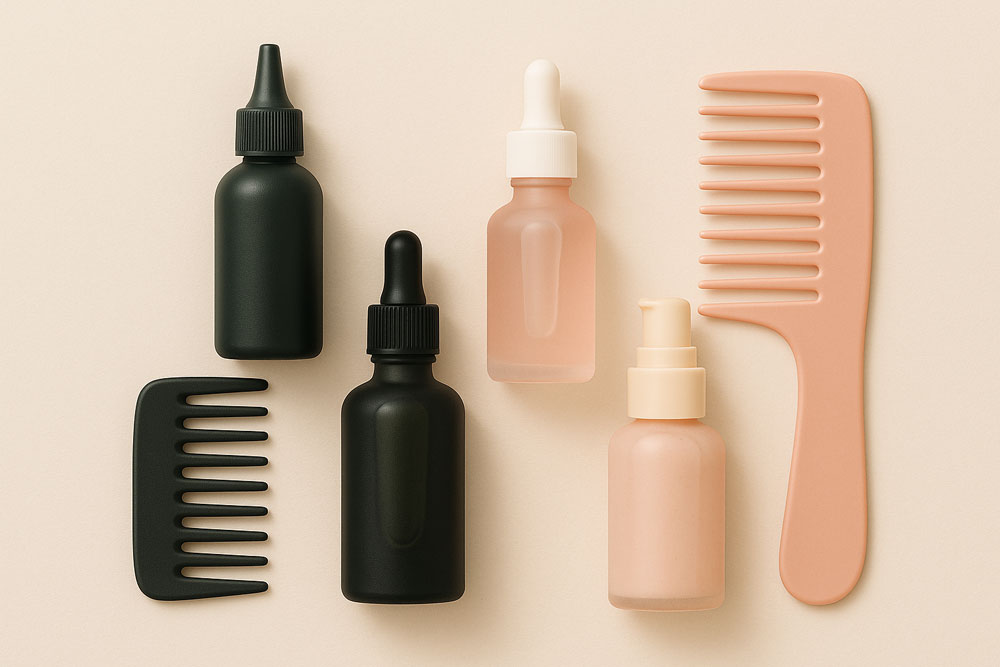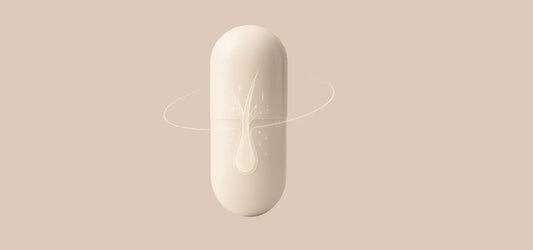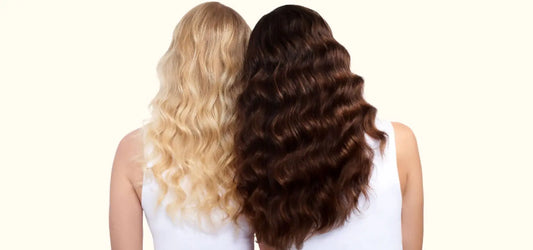Male Vs. Female Hair Loss: What You Need to Know

SHOP this article
OMI
Hair Growth Peptides Capsules
Promote stronger hair growth and scalp health with our unique peptide formula.
Hair loss does not discriminate. In fact, it’s widely common in both women and men, yet the nuances between male and female pattern hair loss are often misunderstood, or at the least oversimplified. Known technically as “androgenetic alopecia” hair loss occurs in both sexes, but the condition’s trajectory, presentation, underlying causes, and treatments can vary significantly. Here, we take a closer look at the differences between hair loss in each gender, and the importance of treating both with compassion and a tailored approach.
Why Hair Loss Isn’t One-Size-Fits-All
The experience of hair loss extends well beyond appearance. It can have a profound impact on self-esteem, identity, and quality of life. While society tends to normalize balding in men, it often stigmatizes thinning hair in women, making it much more emotionally fraught. That’s why it’s especially important to approach male and female pattern hair loss as separate but related conditions.
The clinical term “androgenetic alopecia” refers to a type of non-scarring hair loss that is driven primarily by hormones and genetics. Both men and women inherit susceptibility through their family lines, but how and when that susceptibility expresses itself can look vastly different. Understanding the gender-specific biology behind hair loss informs better treatment choices and helps people experiencing it feel more seen and supported.
The Early Onset of Male Pattern Hair Loss
For many men, hair loss can begin alarmingly early. Some start to notice thinning in their late teens or early twenties, often around the temples or at the crown of the scalp. Over time, these areas may expand and merge, creating the classic horseshoe-shaped balding pattern. This distinct progression is the result of the body’s hormonal makeup, particularly the presence of a powerful androgen called dihydrotestosterone, or DHT.
DHT is a derivative of testosterone and plays a key role in the miniaturization of hair follicles in genetically susceptible men. It binds to androgen receptors at the base of hair follicles, particularly in the frontal and vertex (highest) regions of the scalp. Once bound, DHT causes the hair follicle to shrink and shortens its growth cycle. Hair becomes thinner, shorter, and weaker, and over time, the follicle may stop producing visible hair altogether.
Men naturally produce more testosterone and, by extension, more DHT than women. Additionally, they have higher levels of the enzyme 5-alpha reductase, which is responsible for converting testosterone into DHT. This enzyme is especially concentrated in areas of the scalp most commonly affected by balding, such as the temples and crown. This is the reason it can go unnoticed until a significant amount of hair is gone, and it also explains why it can progress so rapidly once it begins.
The Subtle Progression of Female Pattern Hair Loss
In contrast, women typically experience hair loss later in life, often beginning in their 30s or 40s, though it can become more noticeable post-menopause. Unlike men, women rarely develop receding hairlines or bald spots. Instead, hair loss is more diffuse, especially around the crown and part, which becomes wider over time. This is why it can unnoticed until a significant amount of hair is gone.
While androgens still play a role in female pattern hair loss, the hormonal mix in women differs significantly. Women have lower levels of both testosterone and DHT, and higher levels of the enzyme aromatase, which converts testosterone into estrogen. Estrogen, in many ways, has a protective effect on hair follicles. It helps maintain longer growth phases and may counteract the effects of DHT.
Despite this, women are not immune to the effects of hair-thinning hormones. During menopause, for instance, estrogen levels decline while androgen levels remain relatively steady, tipping the hormonal balance in favor of hair loss. Other factors, such as changes in estrogen receptors (molecular switches that tell genes what to do), inflammation, and thyroid imbalances also contribute to hair loss in women, making it a more complex condition than in men.
How Hair Growth Starts and Stops
Simply put, hair loss is part of the hair growth cycle. This is made up of three distinct phases: anagen, catagen, and telogen. The anagen phase is the growth phase, when hair follicles are actively producing hair. This phase can last anywhere from two to five years, and the longer it lasts, the longer the hair will grow.
The catagen phase is a brief transitional period when hair growth stops, and the follicle begins to shrink. This phase typically lasts two to three weeks. Finally, the telogen phase is a resting period that lasts a few months. During this time, the old hair remains in place until it’s pushed out by new growth underneath.
In a healthy scalp, most hair follicles are in the anagen phase at any given time. However, this balance shifts in those with androgenetic alopecia. The anagen phase becomes shorter, meaning hairs don’t grow as long or as thick. Meanwhile, the telogen phase becomes more dominant. A fourth “kenogen” phase may also occur, leaving the follicle empty and inactive for an extended period between cycles.
The result is progressively thinner, weaker hair. Eventually, some follicles may stop functioning altogether, though they remain under the skin’s surface, and can be reactivated if caught early.
How Treatments Differ for Men and Women
Because the underlying causes of hair loss differ by gender, treatment approaches often diverge as well. Men typically respond positively to therapies that reduce the influence of DHT. The most common first-line treatment is oral finasteride, which blocks the 5-alpha reductase enzyme and reduces DHT levels in the scalp. Topical minoxidil can also increase blood flow and prolong the anagen phase.
In more advanced cases, an oral prescription for minoxidil or another medication known as dutasteride can be more effective at reducing DHT than finasteride. Non-pharmaceutical treatments such as low-level laser therapy, platelet-rich plasma (PRP) injections, and microneedling may also support hair regrowth or improve the thickness of existing hair. When hair loss has stabilized, many men explore surgical hair restoration options like follicular unit extraction (FUE) or follicular unit transplantation (FUT), otherwise known as hair plugs.
For women, treatment follows a more cautious approach, especially when hormonal therapies are involved. Topical minoxidil is the most common treatment, though oral medications that block androgen activity may also be advised, particularly in women with signs of hormonal imbalance, such as acne or irregular periods.
Taking an integrative or natural approach is also a popular option for many women. Supplements that contain vitamins and minerals to increase hair growth such as biotin, zinc, vitamin D, and iron may help, particularly if blood tests show a deficiency. Herbal remedies like saw palmetto and adaptogenic herbs such as ashwagandha or maca are commonly included in hormone-balancing regimens. Good scalp hygiene such as massage and gentle exfoliation, antioxidant serums, and detox treatments are also popular, and a smart, holistic approach.
Hair Growth Peptides: A Promising New Frontier
Among the more recent innovations in hair technology is the use of Hair Growth Peptides, a category of bioactive compounds that show immense promise in revitalizing hair follicles at the cellular level. Unlike pharmaceuticals that primarily work by altering hormones or increasing blood flow, peptides operate on a more subtle biological level by resetting the scalp’s growth environment.
Peptides are short chains of amino acids, the building blocks of proteins that act as messengers in the body. When applied topically or taken as a supplement, certain peptides can bind to receptors in hair follicle cells that support regeneration. This helps prolong the hair’s growth phase and reduces localized inflammation that can damage follicles over time.
Some peptides help improve blood flow, others mimic the body’s natural growth signals, and some deliver structural proteins like keratin back to the follicle. Bioavailable keratin peptides, such as those found in OMI Hair Growth Peptides, have shown an ability to fortify both the hair root and shaft from within. This makes hair stronger, more resilient, and better able to withstand environmental and hormonal stressors.
This approach is especially appealing to women hesitant to use hormonal treatments. Hair Growth Peptides offer a non-hormonal, scalp-friendly alternative that supports hair health without interfering with systemic hormone levels. These also work in concert with a broader hair wellness routine that includes nutritional support, stress reduction, and gentle scalp care.
For men, peptides like OMI Hair Growth Peptides can complement DHT-reducing therapies by nourishing the follicles that remain active and helping improve the quality of newly growing hair. Because they support the follicle’s natural function rather than suppressing hormone conversion, peptide-based formulas are typically well tolerated and come with fewer side effects.
Perhaps most importantly, peptides offer a way to delay or even prevent dormant follicles. This improves overall scalp health, which can help extend the window of opportunity for treatment. This gives both men and women a better chance at maintaining fuller, healthier hair for longer.
Male vs Female Hair Loss: The Mindset Difference
Many men also simply embrace hair loss, while others may feel a loss of youth, masculinity, or control. Still, because male pattern hair loss is so visible and culturally accepted, men are often more open to using scientifically validated, fast-acting treatments, even those with known side effects.
For women, the emotional landscape is much more complex, and the psychological ramifications can be profound. The lack of social acceptance can lead to feelings of shame, embarrassment, anxiety, and even depression. Many women go to great lengths to conceal their hair loss, including changing hairstyles, using volumizing products, or wearing wigs and hairpieces. Long, thick hair is also a cultural hallmark of youth, femininity and sexuality, which makes hair loss for women even more personal and painful.
It also influences the different paths men and women take in pursuit of treatment. Men may be more likely to adopt a clinical, no-nonsense approach focused on efficacy and speed. Women, on the other hand, often seek out treatments that align with their broader wellness goals. This might include hormonal testing, nutritional support, lifestyle changes, and stress management techniques, alongside or in place of conventional medications.
The Importance of Early Intervention
Regardless of gender, one universal truth remains: the earlier hair loss is addressed, the better the outcome. Dormant or miniaturized hair follicles can be revitalized if treatment begins early enough, but once a significant amount of hair is lost it may be too late.
Consistency is also key. Many treatments require daily application or ongoing commitment for months or even years. Results may be subtle at first and may plateau or reverse if treatment is halted. This can be frustrating, especially in an age of quick fixes and instant gratification. However, the rewards of consistent use can be well worth the effort.
Looking Ahead: Hope Through Understanding
It’s important to remember that hair loss is not a personal failure, nor is the emotional fall out many experience a sign of unhealthy vanity or a character flaw. It’s a medical condition influenced by genetics, hormones, aging, and even environmental stressors. Understanding how and why it occurs in men versus women can foster empathy and lead to more personalized, effective care.
As research continues to evolve, new therapies and insights will likely emerge, offering hope to the millions of people navigating hair loss. Until then, awareness and education remain some of the most powerful tools we have. Whether you're just noticing shedding, or you've been living with thinning hair for years, know that you’re not alone, and that there are paths forward to hair regrowth.
Frequently Asked Questions
1. Can hairline thinning be reversed, or is it permanent?
Hairline thinning can often be slowed, stabilized, and even partially reversed, especially if caught early and treated consistently. While complete restoration depends on individual factors like genetics, underlying health, and how long the follicles have been dormant, many people see measurable improvements using a layered approach. The key is consistency, early intervention, and using products with clinically backed ingredients.
2. Is minoxidil effective for regrowing a thinning hairline?
Minoxidil can help slow or reverse early-stage hairline thinning, though results are usually more modest than on the crown.
3. What makes Hair Growth Peptides different from traditional supplements?
Hair growth peptides contain a bioavailable keratin peptide (IFP Hair Factor™) that’s clinically shown to reduce shedding and strengthen hair from within.
4. Can natural herbs like saw palmetto or ginseng really help with hairline thinning?
Some herbs show early promise in supporting hair growth and reducing DHT, though their effectiveness varies from person to person.
5. When should I see a dermatologist about my receding hairline?
Seek professional help if your hairline is rapidly receding, patchy, or your scalp shows signs of inflammation or discomfort.
References
- 1. Ramos PM, Miot HA. Female Pattern Hair Loss: A Clinical and Pathophysiological Review.
- 2. Paus R, Cotsarelis G. The Biology of Hair Follicles
- 3. Sinclair R, Torkamani N, Jones L. Androgenetic Alopecia: New Insights into the Pathogenesis and Mechanism of Hair Loss.
- 4. Kim BK, Lee S, et al. Perception of Hair Loss and Education Increases the Treatment Willingness in Patients With Androgenetic Alopecia: A Population-Based Study
- 5. Sawaya ME, Price VH. Different levels of 5α-reductase type I and II, aromatase, and androgen receptor in hair follicles of women and men with androgenetic alopecia.
- 6. Messenger AG, Sinclair R. Follicular miniaturization in androgenetic alopecia: Histology and genetics.
- 7. Yip L, Rufaut N, Sinclair R. Role of genetics and sex steroid hormones in male androgenetic alopecia and female pattern hair loss: An update of what we now know.
- 8. Herskovitz I, Tosti A. Female pattern hair loss.
- 9. Foligain Blog. Understanding Gender Differences in Hair Loss and Treatment: A Deep Dive.
- 10. Cleveland Clinic Consult QD. Male and Female Pattern Hair Loss: A Guide to Clinical Presentations and Diagnosis.
- 11. Dr. Wolf – Wolf Hair Restoration. Male vs. Female Pattern Hair Loss.
- 12. Everyday Health. Male vs. Female Pattern Baldness (Androgenetic Alopecia).

 8 minutes
8 minutes







